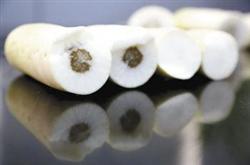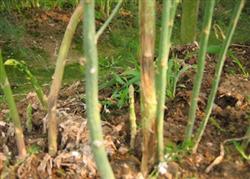Why is the radish hollow?

Why is the radish hollow? What method can prevent and cure radish hollow? Also ask experienced netizens to help guide the farming network to sort out the causes and control methods of radish hollowness, which are listed below for netizens' reference. First, the reasons leading to the hollow radish: 1, the hollow caused by radish varieties: radish can be roughly divided into large, medium and small varieties. Large varieties are deep in the soil, the flesh quality is relatively loose, and the expansion rate of fleshy roots is faster, and when it is larger than the growth rate of leaves, it is easy to hollow; small and medium-sized varieties, the soil is shallow, the meat quality is more dense, the growth rate of fleshy roots is slower, and the growth of roots and leaves is more balanced and not easy to be hollow. 2. Radish hollowness caused by unsuitable sowing time: suitable sowing time should be chosen to make radish grow normally in the environment with high day temperature, low night temperature and large temperature difference between day and night, and it is not easy to cause hollow; on the contrary, the sowing time is too early or too late, it is easy to cause hollow. 3. The hollow caused by radish planting: too thin planting, sufficient nutrients, too fast expansion of fleshy roots, unbalanced growth of roots and leaves, nutrition produced above ground can not meet the nutrients needed for underground fleshy root expansion, so it is easy to be hollow and should be closely planted properly. 4. The hollow caused by improper fertilization of radish: the correct application of fertilizer to keep the balance between aboveground and underground growth is the key to obtain high quality and high yield of radish. Fertilization is unreasonable, especially late topdressing or excessive application of nitrogen fertilizer, so that the growth of leaves is too exuberant and hollow easily. 5. The hollow radish caused by improper watering: the demand for water of radish is also different in different growth stages, so the moisture should be controlled reasonably. Never get wet or dry for a long time. Especially in the peak period of fleshy root growth, the lack of water in the soil not only makes the fibrous root increase, the texture is rough, but also easy to hollow. 6. The hollowness caused by improper radish harvest: the harvest is too early and the output is too low; too late, it is easy to cause hollowness. In addition, if it is placed for a long time after harvest, it is also easy to be hollow. Prevention and control methods of hollow radish: method 1, select excellent varieties: relatively speaking, small and medium-sized varieties with fine meat are not easy to be hollow. Method 2. Select suitable sowing time, reasonable close planting, prevent too thin or too dense, and achieve the goal of high quality and high yield. Method 3. Scientific and rational fertilization: radish fertilization should be based on base fertilizer, supplemented by topdressing, and pay attention to the cooperation of phosphorus and potassium fertilizer to achieve rational fertilization and scientific fertilization. Small and medium-sized varieties with short growth period can be less topdressing if the base fertilizer is sufficient; large varieties with long growth period have long growth period, high yield and large amount of fertilizer, in addition to applying sufficient base fertilizer, they also need to be topdressing by stages. In the early stage of taproot growth, light topdressing should be applied to promote the growth of leaves and roots, and heavy topdressing should be applied at the beginning of fleshy root expansion. Method 4. Reasonable control of water: when sowing, water should be sufficient to achieve rapid root growth, and seedlings should emerge neatly; from seedling stage to fleshy root expansion, it can be irrigated less and reach straight root deep into the soil layer; during the vigorous growth period of leaves, appropriate watering should be required to ensure the growth of leaves; during the peak period of fleshy root expansion, the water supply should be adequate, wet when dry or not drenched for a long time, and the soil moisture should be kept at 70% 80% to prevent hollow. Method 5. Chemical control was adopted: in the later stage of its growth, spraying 10 mg / kg naphthylacetic acid solution at an interval of half a month could delay ripening. Click for more radish planting techniques click to get more vegetable planting techniques
- Prev

What is radish "black heart"?
What is radish "black heart"? Radish black heart is caused by what? Is there any way to prevent and cure it? Also ask netizens to help guide the introduction of radish black rot, commonly known as black heart, rotten heart, the disease is a disease caused by bacteria, planting network sorted out the harm and causes of radish black rot and control methods, the following.
- Next

How does asparagus cultivation prevent stem blight?
What harm does stem blight do to asparagus? How does asparagus cultivation prevent stem blight? Asparagus stem blight is a widespread and devastating disease known as asparagus cancer, which often causes large-scale destruction in the rainy season in summer.
Related
- Where is it suitable to grow horseradish in China? it is expected to see the middle altitude horseradish in Alishan.
- How to prevent tomato virus disease reasonably? (Control methods included)
- Many people like to plant towel gourd on the balcony. What are the main points of this method and management?
- What crops can chili peppers be mixed with?
- Fertilization techniques and matters needing attention in Tomato
- What are the grafting techniques for peach seedlings in spring?
- Harm and control methods of root swelling disease of Chinese cabbage
- What are the pests of sweet potatoes? How to prevent and cure it?
- Symptoms, causes and Control methods of navel Rot in Tomato
- The cause of "Cucumber rotten bibcock" in Farmers' planting Cucumber and its Control Plan

